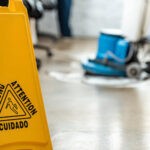Floor buffing is a meticulous process designed to rejuvenate your floors by stripping away layers of floor wax to reveal their original shine. This method essentially exfoliates the surface, offering a glossy and more appealing appearance. Almost all waxed floor types, including wood, concrete, vinyl, and laminate, are suitable candidates for buffing.
When it comes to floor buffing, it primarily falls into two categories:
1. Spray Buffing:
- Description: This method employs a liquid solution to eliminate dirt from the floor and enhance its shine. It combines a polishing solution with the mechanical action of the buffer pad to remove scuffs, level the surface, and boost the shine. Spray buffing is the more commonly used technique.
- Equipment: You’ll need a buffing machine (high-speed buffer), suitable buffing pads, and a spray solution for this method.
2. Dry Buffing:
- Description: Dry buffing, on the other hand, does not require a liquid spray. It involves using a buffing machine and pad to achieve a shiny finish without the need for a spray solution.
- Equipment: The essential equipment for dry buffing includes a buffing machine and appropriate buffing pads.
Floor Buffing Equipment:
- Buffing Machine (High-Speed Buffer): The choice of buffing machine depends on the size of the space, your budget, and the type of floor. Smaller spaces are best served by handheld buffers, while larger areas benefit from heavy-duty buffers, especially in commercial settings. Rental options are readily available at equipment rental establishments.
- Buffing Pads: Select buffing pads based on the type of buffer, its speed, and the nature of the floor. The fiber type and the extent of dirt and scuffs on your floor also factor into your choice. Using an overly aggressive pad on a lightly soiled floor can harm the finish, leaving an unsightly result. For new waxed floors, opt for a white pad, while high-traffic areas may require a red or gorilla hair buffing pad. Buffing pads are available online or at your nearest janitorial supply store.
- Spray Liquid: If you’re opting for the spray buffing method, the spray solution is essential. This, along with the buffing pads, can be easily acquired at your local janitorial supply store.
Floor Buffing Procedure:
- Prepare the Area: Prior to starting the buffing process, clear the area of any obstacles or objects that might interfere with the work. Make sure to use wet floor signs to block off the area.
- Clean the Floors: Thoroughly clean the floor to eliminate any debris or dirt. This step is crucial, as dirt buffed into the finish can’t be rectified without stripping the floors. Cleaning can involve either scrubbing and rinsing or sweeping/vacuuming and mopping, depending on your preference. Ensure the floor is completely dry before commencing the buffing process.
- Spray on the Buffing Solution (For Spray Buffing): If you’re opting for the spray buffing method, apply the solution evenly using a spray applicator for a uniform application. Avoid over-spraying, as this can cause pad marks on the floor. The initial application spreads the solution for a clean appearance, and you can apply a second coat for a glossier finish.
- Buff the Floors: Using your buffing machine, work in sections, typically 3 feet by 3 feet, moving the machine back and forth to cover the entire surface evenly. Concentrate on any scuff marks by lingering over them for a better result. Always use a clean pad for optimal outcomes, ensuring it’s not clogged, which may impede proper polishing.
- Dry Buff the Floors (Optional): After spray buffing, a final round of dry buffing can be performed to remove any residual spray solution and achieve an even shinier look.
- Apply a Finish (Optional): To enhance shine and longevity while making the floors slip-resistant, applying a finish is recommended. This step is not obligatory.
- Frequency and Floor Care: The frequency of floor buffing depends on the traffic your facility experiences and the regularity of floor sweeping and mopping. Smaller offices may require buffing quarterly, while high-traffic areas like hospitals may need monthly attention. Ongoing custodial services and proper cleaning solutions are essential for maintaining a clean, glossy floor. Avoid using harsh cleaning agents like bleach or degreasers, as they can damage the floor’s wax coating. Neutral cleaners or vinegar are suitable alternatives. It’s also crucial to ensure that mop heads are regularly replaced or cleaned, as dirty mops can spread dirt and create build-up.
Additional Tips:
- Hand-address corners and edges, as buffing machines may not reach these areas effectively.
- Avoid contact with baseboards to prevent scratching.
- For floors with significant scratches or build-up, consider power scrubbing with a low-speed buffer and reapplying a minimum of three coats of floor wax.
Cost of Service: To determine the cost of floor buffing for your project, we recommend scheduling a site visit for a comprehensive assessment. The quote provided will consider factors such as square footage, floor condition, and the required service frequency. For your customized quote, please contact us at 713.900.9192 or request a call through the provided link.
In conclusion, floor buffing is a tried-and-true method for revitalizing your flooring, enhancing its glossiness, and extending its lifespan. Careful selection of buffing pads is key to achieving the desired results. The frequency of buffing varies depending on your facility’s needs, so it’s essential to adapt the service to your specific requirements and maintain the luster of your floors.


22 Comments